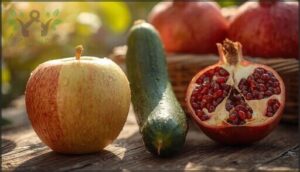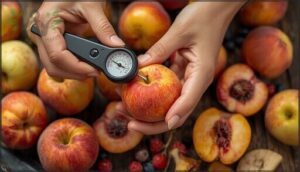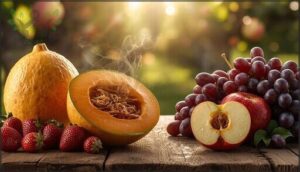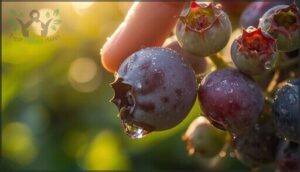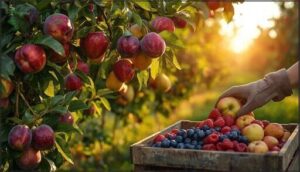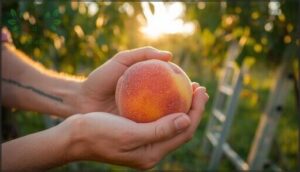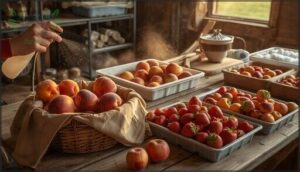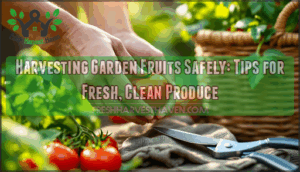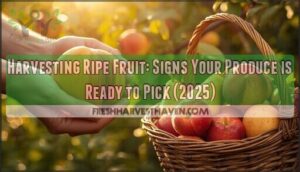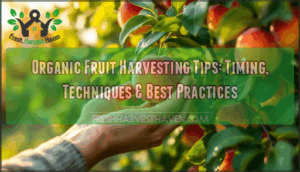This site is supported by our readers. We may earn a commission, at no cost to you, if you purchase through links.
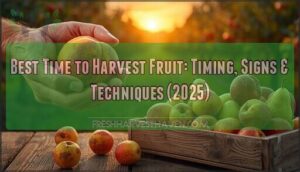
The tricky part? Fruit doesn’t ripen on a calendar schedule. Temperature swings, rainfall patterns, and even your soil’s health shift harvest windows by days or weeks. A perfectly ripe apple picked on Tuesday might have been underripe on Friday and overripe by Sunday.
Learning to read the subtle signs—color shifts, firmness changes, that telltale sweet aroma—turns guesswork into confidence, helping you catch your fruit at peak flavor and quality.
Table Of Contents
Key Takeaways
- Harvest timing depends more on reading physical signs—color shifts, firmness, aroma, and easy stem detachment—than following calendar dates, since weather, soil quality, and variety differences can shift windows by weeks.
- Climacteric fruits like apples and pears continue ripening after picking and can be harvested slightly early, while non-climacteric fruits like berries and citrus must be picked fully ripe or they’ll never improve.
- Post-harvest handling in the first six hours is critical—immediate cooling, proper storage temperatures (0-4°C for most fruits), and humidity control (90-95%) can extend shelf life from days to months.
- A single timing mistake can be devastating, as demonstrated by the commercial grower who lost 40% of their peach crop worth $80,000 by waiting just three days too long to harvest.
Key Factors Affecting Fruit Harvest Timing
Getting your harvest timing right isn’t just about watching the calendar—it’s about understanding the unique conditions shaping your fruit’s development. Several key factors work together to determine when your crops hit peak ripeness, and ignoring even one can mean the difference between mediocre fruit and a great harvest.
Let’s look at the main influences you’ll need to think about when planning your picking schedule.
Climate and Weather Influences
When it comes to nailing your harvest timing, weather influence plays a bigger role than most folks realize. Growing season shifts, precipitation patterns, and extreme weather events directly shape when your fruit reaches peak ripeness—and understanding these patterns helps you pick at just the right moment.
Here’s how weather impacts fruit harvest timing:
- Temperature and chill accumulation determine when trees exit dormancy and begin their growth cycle, with warmer springs advancing harvests by up to two weeks in recent years.
- Rainfall timing matters enormously—June precipitation boosts peach yields by 61 bushels per inch, while July rain can reduce yields by nearly 11 bushels.
- Sunlight exposure and day length trigger ripening processes differently across fruit types, making location and seasonal light patterns critical factors.
- Weather monitoring before harvest is essential—you’ll want 2-3 days of dry conditions to reduce disease risk and improve storage quality. Understanding hyperlocal weather data can further hone harvest predictions.
Variety and Cultivar Differences
Beyond weather patterns, fruit varieties themselves carry unique genetic timelines. Your ‘Goldrush’ apple won’t ripen until 56 days after ‘McIntosh’—that’s nearly two months of ripening variance between cultivars. Geographic effects heighten these differences: ‘Norland’ apples mature three weeks earlier in prairie provinces than in Anchorage.
Cultivar traits affect fruit maturity, fruit quality, and even disease susceptibility, making variety selection essential for optimizing fruit flavor and harvest predictability. To better predict harvest dates, consider using growing degree hours.
Soil Quality and Sunlight Exposure
Soil quality shapes fruit maturity in unexpected ways. Your soil pH between 5.5 and 7.0 optimizes nutrient uptake, while higher organic matter directly improves fruit flavor and firmness.
Light intensity matters too—every 1% increase in sunlight exposure boosts your yield by roughly 1%.
Soil texture affects drainage and root access, ultimately controlling how fast your fruit reaches peak ripeness for harvesting.
Irrigation and Water Availability
Water availability shifts your harvest timing more than most growers realize. Deficit irrigation cuts yield by 9-20% but improves water productivity by up to 13%. Timing matters—irrigate during flower formation and final fruit swell (2-4 weeks before harvest) for best fruit quality.
When you control moisture correctly, you’ll boost fruit size, enrich flavor development, and improve the economic impact of every harvest while matching ripening stages to market demands.
Signs Your Fruit is Ready to Harvest
Knowing when your fruit is ready to pick can feel like guesswork, but your plants are actually sending clear signals if you know what to look for. Each type of fruit has its own ripeness cues, and learning to read them makes all the difference between a mediocre harvest and a wonderful one.
Here are the key signs that tell you it’s time to grab your basket and head to the garden.
Color and Size Changes
Color development and size are your bread-and-butter harvest readiness signs, but they work best as combined metrics rather than solo acts. Here’s what to watch:
- Apples shift from green to yellow or achieve 50–60% red coverage when they’re commercially ready
- Cucumbers hit their sweet spot at 9–11 cm long, usually 10–12 days after fruit set
- Pomegranates gain significant weight as color deepens, signaling peak ripeness
These ripeness indicators vary by cultivar, so technological assessment tools like DA meters now help growers quantify color changes objectively.
Remember, fruit maturity stages show high variability even within the same tree—check multiple specimens before you start picking in earnest.
Texture and Firmness Cues
Firmness and texture indicators of fruit ripeness often reveal more than appearance alone. Handheld penetrometers let you measure fruit texture objectively—apples need at least 15 lbs firmness for long-term storage, while peaches destined for market should clock in above 6–8 lbs.
These biological determinants directly affect postharvest quality, making instrument firmness readings your secret weapon for best harvest timing and reducing supply chain losses.
Aroma and Flavor Development
Aroma signals ripening volatiles at work—ripe cantaloupes release a sweet fragrance at the blossom end, while strawberries develop methyl hexanoate for that classic berry perfume.
Climacteric differences matter: apples continue flavor development after picking, but grapes and berries don’t improve post-harvest.
Check your fruit’s sugar-acid ratio by tasting—when sweetness balances tartness without storage deterioration notes like ethanol, you’ve hit the sweet spot for harvesting peak flavor.
Detachment and Ease of Picking
When ripe fruit separates with minimal pull force—usually 0.41 to 0.75 Newtons for blueberries—you’re working with nature’s detachment signal. Gentle fruit detachment that requires little pressure prevents bruising and indicates readiness.
Abscission zone genes naturally weaken stem attachment as fruit matures, making picking fruit easy. If you’re tugging hard during harvesting, wait a few more days for an easier, damage-free harvest.
Best Harvest Times for Popular Fruits
Each fruit has its own calendar, and knowing when to harvest can mean the difference between a bland bite and pure sweetness. While general signs of ripeness help, timing varies widely depending on what you’re growing.
Let’s look at the best harvest windows for some of the most popular backyard fruits.
Apples, Pears, and Stone Fruits
You’ll notice the harvest window for apples, pears, and stone fruit varieties varies considerably based on bloom dates and regional growing conditions. Apple harvest timing generally runs August through November—Gala apples mature in 120–140 days after full bloom, while Granny Smith needs 170–190 days.
- Pears ripen best off the tree: Bartlett, Bosc, and D’Anjou varieties picked August–December need cold storage below 40°F for about a month to develop proper texture
- Stone fruits follow summer patterns: Cherries start in June/July, apricots mature late July–August, and plums are ready by September
- Watch for color shifts: Apples show yellowish-green background skin when ready; plums should be firm-ripe and well-colored
Post-harvest handling matters—proper storage duration extends your enjoyment through March for many apple varieties.
Berries (Strawberries, Blueberries, Blackberries)
Berry picking demands perfect timing—strawberries, blueberries, and blackberries won’t ripen once picked. Strawberries hit peak harvest May through early July in most regions, while blueberries follow June–August. You’ll recognize ripeness cues through deep color and easy detachment from stems.
Handpick carefully to prevent bruising, since 54% of U.S. consumers buy these berries fresh.
Post-harvest handling matters: cool immediately and store properly to maintain quality.
Citrus Fruits (Oranges, Lemons)
Citrus fruits follow a longer harvest timing than berries—sweet oranges ripen December through March, while Meyer lemons mature August to February. Unlike climacteric fruits, these nonclimacteric fruits won’t ripen after picking, so wait until they’re heavy for their size with uniform color. Harvesting tools like clippers prevent stem damage.
Proper storage duration extends freshness: citrus holds weeks in cool conditions, directly impacting economic returns through reduced spoilage.
Grapes and Melons
Table grapes and melons demand careful attention to grape ripeness signs since they won’t ripen after picking. Grapes generally reach peak maturity late August through September—you’ll spot that telltale whitish bloom and brown seeds signaling harvest timing. Melons follow from late June through summer, with muskmelons picked at the “half-slip” stage for best muskmelon flavor.
- Grapes store up to eight weeks at 32°F with proper humidity
- Muskmelons reach eating maturity three days after harvest at 70°F
- Table grape timing varies by region and variety selection
- Melon harvest stage affects sweetness and shelf life greatly
Cherries and Other Specialty Fruits
Cherry harvest windows open April through August depending on your location—California growers start April 25, while Washington State runs June through August. Apricot yield variation runs July to August with pluot summer harvest following similar patterns. Cranberries use unique wet methods in flooded fall bogs. European pear ripening requires cold storage after picking, unlike most fruit.
| Fruit Type | Harvest Window | Special Handling |
|---|---|---|
| Sweet Cherries | April 25–August | Hand-pick at full color |
| European Pears | August–December | Ripen in cold storage |
| Cranberries | Fall (September–November) | Wet harvest in bogs |
Harvesting Techniques for Peak Quality
Knowing when to pick your fruit is only half the battle—how you harvest matters just as much. The right technique protects your crop from bruising, preserves flavor, and can even extend shelf life by weeks.
Let’s walk through the methods that keep your harvest in top shape from tree to table.
Hand-Picking Vs. Cutting Methods
When you’re deciding between hand-picking and cutting methods for fruits, you’ll want to weigh labor cost analysis against quality. Hand-picking allows selective harvesting benefits—you can leave unripe fruit behind—and keeps picking damage rates under 5% for delicate varieties.
Cutting methods slash labor costs by up to 70%, but mechanical debris levels can jump 250%. Sharp tools matter: blunt blades trigger faster browning and reduce shelf life.
Preventing Bruising and Damage
After all your effort picking at the right moment, you don’t want to lose quality to preventable damage. Worker training and gentle handling cut bruise rates by 30–40%, especially when you keep drop heights below 20 centimeters. Harvest timing matters too—afternoon picking reduces bruising by 30%.
Clean, sanitized containers slash decay risk by 70%, and careful fruit handling protects your harvest’s shelf life.
Tools and Equipment for Safe Harvest
With the right gear, you’ll work safely and protect your crop. Specialized picking bags with cushioned interiors cut fruit drop damage by over 15%, while tripod orchard ladders on uneven ground have reduced fall injuries by 30%.
Sharp, sanitized cutting tools lower contamination by 40%, and rubber-coated picking poles enable gentle handling of high-hanging fruit while reducing skin punctures by 22%.
Post-Harvest Tips to Preserve Freshness
Getting your fruit off the tree is just half the battle—what you do in the next few hours can make or break its shelf life.
The right post-harvest steps keep your produce tasting fresh for weeks instead of days. Let’s walk through the key practices that’ll help you preserve all that hard-earned flavor and quality.
Immediate Cooling and Cleaning
Once you pick your fruit, think of the clock as your enemy. Immediate cooling and cleaning are critical for fruit preservation—delays beyond six hours can slash shelf life and boost spoilage.
Use rapid cooling methods to drop temperatures fast, then wash with clean water and approved cleaning agents for microbial reduction.
This smart postharvest handling cuts waste, protects your harvest, and keeps fruit handling simple and effective.
Proper Storage Conditions
Temperature control and humidity levels make or break fruit storage success. Most fruits thrive between 0°C and 4°C with 90–95% humidity—conditions that can extend shelf life up to six months. Citrus prefers slightly warmer temps (7–10°C) to avoid chilling injury.
Don’t overlook gas composition and packaging types: controlled atmosphere storage and proper containers can double your fruit preservation window while maintaining peak quality.
Ripening After Harvest (Climacteric Vs. Non-Climacteric)
Understanding fruit ripening after harvest helps you avoid disappointment—some fruits sweeten on your counter, others won’t budge. Climacteric fruits like apples and tomatoes continue ripening off the plant, their ethylene production triggering starch conversion and sweetness gains up to 40%. Non-climacteric fruits such as strawberries and citrus must be picked fully ripe.
Some fruits ripen after picking while others must be harvested fully ripe—knowing the difference prevents wasted effort and disappointment
- Climacteric fruits complete postharvest ripening if picked at physiological maturity
- Non-climacteric fruits show 70–90% quality decline without on-plant ripening
- Ethylene application speeds climacteric ripening stages but barely affects non-climacteric types
- Respiration rates double in climacteric fruits, extending practical shelf life with proper timing
Freezing, Canning, and Drying Methods
Freezing quality retention peaks when you lock in fruit at -18°C or colder—this preserves over 93% of carotenoids and boosts vitamin C by 34% compared to hot-air drying.
Canning safety concerns arise when jars don’t seal (affecting 32% of home canners), while drying nutrient preservation depends heavily on temperature—freeze drying wins for sensory changes and antioxidant retention, fueling market growth in fruit preservation methods.
Frequently Asked Questions (FAQs)
How does harvest timing affect fruit market value?
Like a perfectly timed symphony, harvest timing orchestrates fruit quality—determining sugar content, firmness, and shelf life.
You’ll see price premiums for peak maturity while minimizing post-harvest losses through consumer preference alignment.
What are common mistakes when harvesting backyard fruit?
Ripeness misjudgment and improper tools lead to bruising prevention failures. Harvesting fruits too early or too late damages quality—common mistakes to avoid when harvesting fruits that reduce yield considerably.
Storage delays cause up to 50% losses.
Can you speed up fruit ripening on trees?
Yes, but only for climacteric fruits like apples and pears. Ethylene PGRs, environmental manipulation through heat exposure, or cultural practices like girdling can accelerate fruit ripening on trees by days.
How has climate change impacted traditional harvest schedules?
Climate change has accelerated fruit ripening dates by up to two weeks, disrupting traditional harvesting schedules.
Phenological shifts caused by warmer springs affect supply chain timing, regional variations in crop maturity, and adaptation strategies growers must now implement.
What safety precautions should fruit harvesters take?
You need proper PPE compliance—gloves, eye protection, and headgear—to prevent injuries during fruit harvesting.
Ladder safety, heat stress prevention, ergonomic risks management, and chemical safety protocols protect against common hazards like falls and pesticide exposure.
Conclusion
Don’t let your harvest plans fall flat—the best time to harvest fruit isn’t stamped on any calendar. It’s written in color shifts, firmness tests, and that unmistakable sweet scent hanging in the morning air.
Master those subtle cues, and you’ll catch every apple, peach, and berry at peak ripeness. Miss them, and you’re left with regret instead of flavor.
Your orchard’s success hinges on reading nature’s signals, not guessing.
- https://research.reading.ac.uk/research-blog/2024/03/29/what-your-fruit-bowl-reveals-about-climate-breakdown/
- https://www.nature.com/articles/s41598-025-92015-7
- https://nyshs.org/wp-content/uploads/2015/10/Watkins-Pages-from-NYFQ-Book-Fall-2015-6.pdf
- https://oehha.ca.gov/climate-change/epic-2022/impacts-vegetation-and-wildlife/fruit-and-nut-maturation
- https://www.sciencedirect.com/science/article/abs/pii/S0950329308000414

